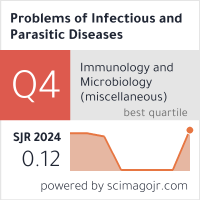First cases of culture proven Legionnaires’ disease in Bulgaria
DOI:
https://doi.org/10.58395/pipd.v48i3.41Keywords:
Legionella pneumophila, Legionnaires’ disease, typing, culture from clinical samplesAbstract
Background. Legionella pneumophila is the most common cause of the potentially fatal Legionnaires’ disease with worldwide increasing incidence reports. The bacterium is fastidious and slow growing and most laboratories do not perform culture.
Aim. To present results from the first culture proven cases of Legionnaires’ disease in Bulgaria.
Materials and methods. Ten lower respiratory tract materials from 10 patients were cultured for legionellae with GVPC supplement. Identification was based on growth characteristics, latex agglutination and monoclonal typing.
Results. Seven L.pneumophila strains (serogroup1 and serogroup6) were isolated. Five belong to monoclonal sub-types Allentown/France, Knoxville and Philadelphia. One culture positive sputum was received at the lab 5 days after sampling. Other materials were plated on the day of sampling, but three of them were obtained long after specific therapy was started and remain negative on culture. Five from the ten patients were with fatal outcome. Three were reported to ELDSNet in real-time as travel-associated.
Conclusions. Isolation of legionellae from patients remains the diagnostic ‘gold standard’. The use of selective supplement designed for water samples had no obvious impact on our results in contrast with late sampling. Isolates were from the most frequent reported L. pneumophila serogroups and five of them – from the virulence-associated Pontiac sub-groups. Legionnaires’ disease is still underdiagnosed in Bulgaria. Clinicians must be encouraged to send appropriate and timely obtained respiratory materials. This should happen even in cases with other positive microbiological results, since co-infection with viral, fungal or other bacterial pulmonary pathogens might be of importance for patients’ treatment and health.
Downloads
References
European Centre for Disease Prevention and Control. Legionnaires’ disease. In: ECDC. Annual epidemiological report for 2018. Stockholm: ECDC; 2020.
Dooling K., Toews K-A., Hicks L.A. et al. Active Bacterial Core Surveillance for Legionellosis — United States, 2011–2013. MMWR, 2015, 64(42), 1190-1193.
Tomov A., Tsvetkova E., T sanev N. et al. Isolation of Legionella pneumophila in Bulgaria. Zentralbl Bakteriol Mikrobiol Hyg A. 1981,250(4),521-8.
Tsvetkova E., Tomova I., Halova B. et al. Isolation of legionellae from hotel water supplies in Sofia. Probl. Infect. Par. Dis. 2002, 30 (2), 14-16.
Tomova I., Panayotov S., Levterova V. et al. Characterization of Legionella pneumophila isolates from geographically different Bulgarian regions. Clin. Microbiol. Infect. 2005, 11, Suppl. 2, 430.
Tomova I., Marinova L., Filipova R. Travel Associated Legionnaires' disease - a health and tourism problem. Infectology. 2006,1,43-46. (in Bulgarian).
Helbig J., Bernander S., Castellani Pastoris M. et al. Pan-European Study on Culture-Proven Legionnaires' Disease: Distribution of Legionella pneumophila Serogroups and Monoclonal Subgroups. Eur J Clin Microbiol Infect Dis. 2002,21, 710–716.
Muder R.R., Yu V.L., Fang G.D.. Community-acquired Legionnaire's disease. Semin Respir Infect. 1989,4,32–39.
Vergis N., Abkas E., Yu V. L. Legionella as a cause of severe pneumonia. Semin. Respir. Crit. Care Med. 2000, 21, 295–304.
Benin A., Benson R., Besser R.. Trends in Legionnaires disease, 1980–1998: declining mortality and new patterns of diagnosis. Clin. Infect. Dis.. 2002, 35,1039–1046
Fraser D.W., Tsai T.R., Orenstein W. et al. Legionnaires' disease: description of an epidemic of pneumonia. N.Engl.J.Med. 1977, 297(22),1189-97.,
Den Boer,J., Yzerman Ed P.F. , Schellekens J. et al. A large outbreak of Legionnaires' disease at a flower show, the Netherlands, 1999. Emerg Infect Dis. 2002,8(1),37-43
García-Fulgueiras A., Navarro C., Fenoll D. et al. Legionnaires’ Disease Outbreak in Murcia, Spain. Emerg Infect Dis. 2003, 9(8),915-921
Nguyen T., Ilef D., Jarraud S. et al. A Community-Wide Outbreak of Legionnaires Disease Linked to Industrial Cooling Towers-How Far Can Contaminated Aerosols Spread? J.Infect.Dis. 2006,193(1),102-11.
Nygard K., Werner-Johansen Ø., Rønsen S. et al. An Outbreak of Legionnaires Disease Caused by Long-Distance Spread from an Industrial Air Scrubber in Sarpsborg, Norway. Clin.Infect.Dis. 2008,46(1),61–69.
Shivaji T, Sousa Pinto C, San-Bento A et al. A large community outbreak of Legionnaires disease in Vila Franca de Xira, Portugal, October to November 2014. Euro Surveill. 2014,18;19(50):20991.
Cassini A., Colzani E., Pini A. et al. Impact of infectious diseases on population health using incidence-based disability-adjusted life years (DALYs): results from the Burden of Communicable Diseases in Europe study, European Union and European Economic countries, 2009 to 2013. Euro Surveill. 2018;23(16).
Lock K., Millett C., Heathcock R. et al. Public health and economic costs of investigating a suspected outbreak of Legionnaires' disease . Epidemiol.Infect. 2008,136(10),1306-14






